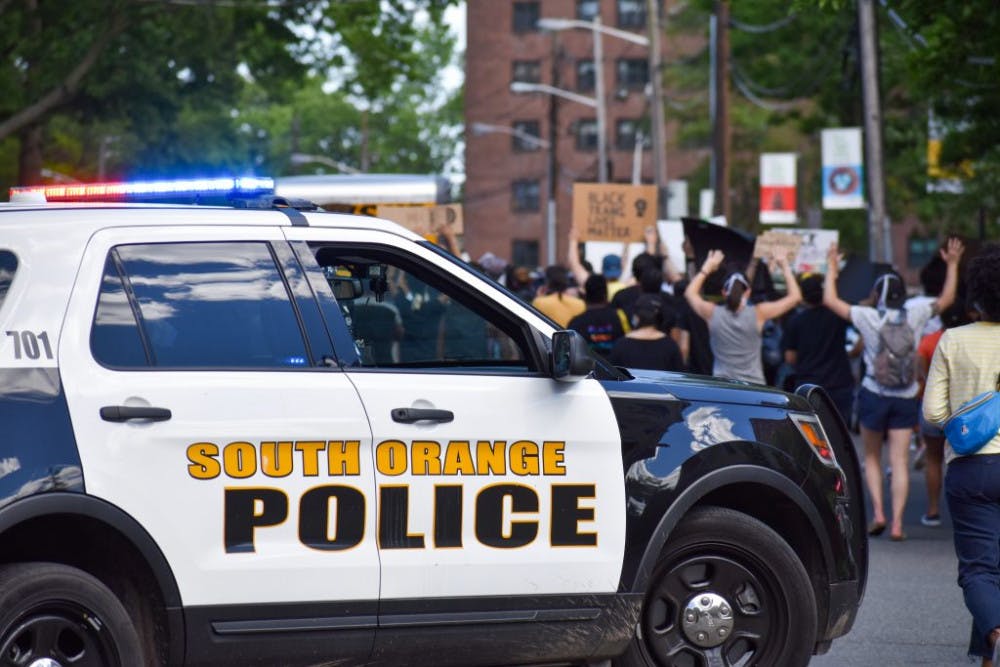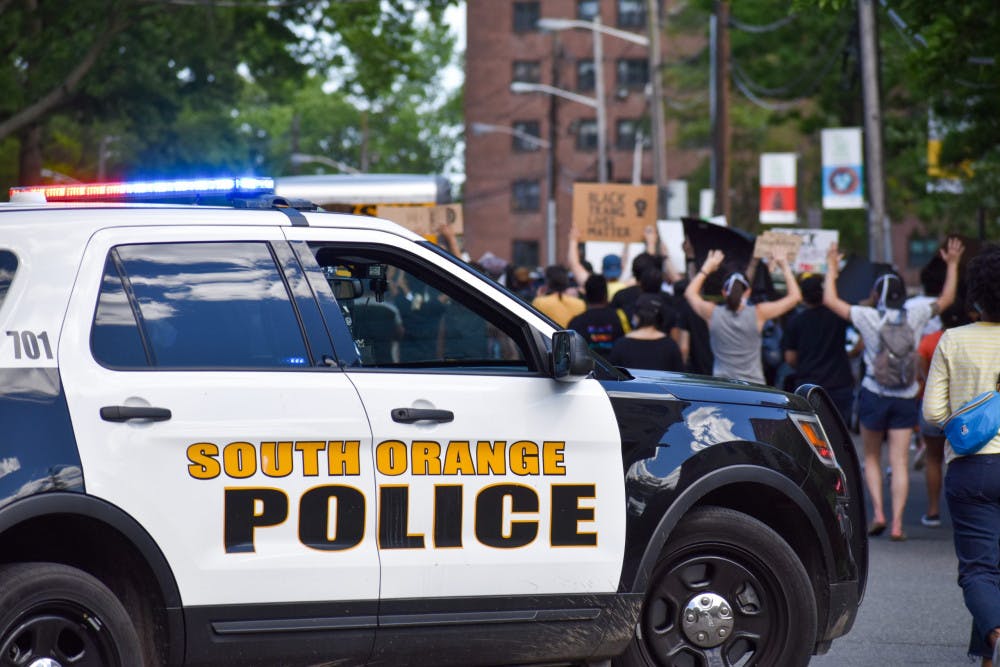Student Services hosted a virtual “panel on policing” on Tuesday to discuss issues of criminal justice, equality and engagement in the Seton Hall community and beyond.
The panel is the second in a series of events planned by the Student Services to address diversity and inclusion in the wake of the death of George Floyd at the hands of the Minneapolis Police Department. The event featured speakers from the South Orange and Newark Police Departments, Seton Hall Public Safety, and others with expertise in areas of justice and policing.

“Just over a month ago, I had the privilege of providing remarks to our community as part of the student-led demonstration of solidarity,” Vice President of Student Services, Dr. Shawna Cooper-Gibson said. “We recognized that diverse conversations need to happen with many different voices to engage and promote dialogue. This includes various topics of policing; exploring the history of policing in the U.S. and at Seton Hall, and perspectives on de-escalation techniques, funding, media coverage, and community building.”
Patrick Linfante, Director of Public Safety at Seton Hall, described the changes that his department has undergone during his time in the job.
“I arrived on the scene in July of 2000, and my task was obvious. To restructure the department and regain the confidence and trust of the community.”
Linfante described the expansion of Public Safety services, including the introduction of SafeRide and SHUfly transportation services, and the expansion of surveillance cameras on campus.
Linfante did not go into detail before the panel on how his department handles complaints. He expanded on the topic in an email with The Setonian.
“Public Safety investigates all complaints received,” Linfante said. “If the complaint is of a criminal nature we will involve, with the consent of the complainant, law enforcement authorities.”
One major topic of discussion was community policing, which has been embraced by the Newark Police Department (NPD) and the South Orange Police Department (SOPD), according to representatives from those departments.
Community policing refers to a wide range of programs and ideas of how police funding should be spent, generally with a focus on community engagement and involvement. In South Orange, this takes the form of several initiatives, as well as a “civil service” model of hiring, under which applicants from South Orange are prioritized.
“South Orange Police Department is basically staffed by members of the community who are supporting the community,” SOPD Sergeant Richard Lombardi said to the panel. “As far as community policing goes, the most important parts of it are engagement and dialogue.”
South Orange’s community policing initiatives include youth engagement programs, safety programs for the elderly and the Community Policing Collaborative (CPC), which seeks to create dialogue on policing with community members.
To the east, in Newark, community policing has been in use for several years. Newark Police Captain Brian O’Hara credited a decrease in crime in the City to the reforms and community engagement initiatives spearheaded by Newark Mayor Ras Baraka.
“Newark has done some very deliberate things, it’s been driven by the consent decree (a document that outlines the services of the NPD), but also by the leadership of the city by this mayor and this mayor’s vision for how he wants this city to be different than the way we’ve been perceived and judged in the past,” O’Hara said.
Newark has had 20 murders this year so far, O’Hara said. In December 2019, NPD reported that there were 51 murders that year, the lowest murder rate the city had seen since the 1960s.
O’Hara pointed out the nature of recent Black Lives Matter protests in Newark, which remained peaceful despite nationwide unrest the City’s history of rioting, as proof that Newark is making progress. In 1967, 26 people died and hundreds were injured in a race riot that lasted several days in Newark. Captain O’Hara said that the change from rioting to peaceful protest demonstrated how well community policing has worked.
Speaking about one incident that involved a congregation of individuals protesting the death of George Floyd on May 30 outside of Newark’s First Police Precinct, O’Hara cited community intervention as a reason that tensions did not escalate between protesters and police.
“Their intention, from what [some protesters] said was to burn [the NPD precinct] building down,” he said of the incident. “It was our community that was out there telling folks, ‘no, you’re not going to do that here,’ and working with us to prevent that from happening. To me, if that doesn’t demonstrate the relationships of where we are today in Newark, I don’t know what does.”
Both O’Hara and Lombardi, each touting the reforms of their respective departments, stopped short of calling for a defunding of the police.
Dr. Sara Wakefield, a sociologist and researcher with Rutgers University’s School of Criminal Justice, elaborated on what it means to “defund the police,” explaining that the phrase has been used to refer to many different ideas of police reform, from full abolition of police departments and prison systems to reducing the budget of departments to distribute municipal funds to social workers, psychological services, and other services which could help reduce crime.
“I think the reason the question [of what it means to defund the police] is coming up so much is because it is being used by so many different people to mean different things.”
Wakefield, a South Orange resident, is involved in the Community Policing Collaborative (CPC), and called the initiative “a start.”
“I don’t think community policing means much of anything… It tends to mean so many things that it ends up meaning nothing,” Wakefield said in an email. “I have enjoyed working on the CPC and find [South Orange Police Chief] Kroll to be open to feedback, transparent, and highly committed to the South Orange community, even in areas where [the CPC] would like him to change practices in the department and he may personally disagree. That’s a good start, but it’s not a finish.”
The panel discussion continued onto how local police handle complaints of use of force.
SOPD Sergeant Lombardi explained that his department has an entire group dedicated to handling complaints regarding officer demeanor and use of force.
“We have policy in place to make sure that the vast majority of our interactions with the public are audio and video recorded when applicable,” Sergeant Lombardi said.
One such recorded January interaction was made public by the South Orange government on May 20. The incident involved a young Black man arrested for suspected robbery on Sloan Street and an SOPD officer who punched the suspect five times after saying that he was resisting arrest.
The officer involved was suspended in January, and in May a statement on the Village’s website reported that an investigation into the officer’s actions by South Orange Police Internal Affairs had been completed and that “the officer has been issued a preliminary notice of disciplinary action seeking the officer’s removal. Pending the outcome of a hearing, the officer will remain suspended.”
South Orange does not currently have a publicly available listing of use of force complaints against SOPD, but a community presentation by the Village includes data on use of force for the years 2012-2018.
SOPD reported 82 uses of force in the seven year period. 76.8% of these incidents involved Black suspects. Black people made up 28.6% of South Orange's population at the 2010 census.
In 2017, NJ Advance Media published "The Force Report," a list of all police brutality and use of force incidents for every municipality in New Jersey. The report includes over 43,000 incidents statewide between 2012 and 2016.
"That's the equivalent of about one every hour, every day, for five years," the report says.
The report includes a "force rate," a calculation of incidents per 1000 arrests, to compare rates of brutality between departments.
SOPD is listed as having a force rate of 45.2, above the state average of 30.5. NPD had a rate of 28.6.
Nearby Maplewood, which is closely tied to South Orange, had a force rate of 111.
Panelists discussed the NJ Advance Media report, with some of them taking issue with its methodology.
"I think the problem with [the report] was that people could see it and think they could compare an officer in South Orange with one somewhere in South Jersey," O'Hara said. "We know from our own experience here that there's variation in how force gets reported, especially at the lower levels. A lot of the time police officers don't understand that they need to report the very lowest levels of use of force.”
Both SOPD and NPD, as well as Seton Hall Public Safety, use implicit bias testing to address racial bias in policing, they said at the panel.
Dr. Wakefield, however, downplayed the effectiveness of implicit bias testing.
"I've actually taken implicit bias tests in front of my students, and I am able to, sort of, game it," she said. "It's a broader question about how we deploy law enforcement in a way that doesn't create [racial] disparities, because it doesn't require someone to be biased in their heart to produce those kinds of disparities."
Student Services plans to have a follow-up panel on policing in September, according to Dr. Cooper-Gibson
"There is no group, administration, students, executive board, faculty, religious community,” Dr. Cooper-Gibson said, “Not one area - that is exempt from working together and making a better, more just, more welcoming Seton Hall.”
Daniel O’Connor can be reached at daniel.oconnor1@student.shu.edu. Find him on Twitter @ItsDanOConnor.





